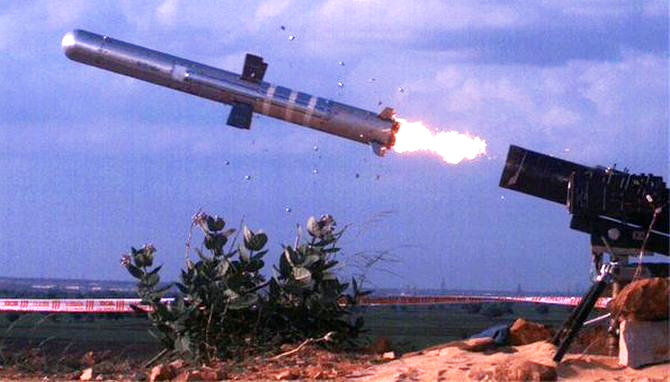Unless you are one of the biggest contractors in this space, defence is a tough business to crack. But Tonbo Imaging, a night-vision startup backed by top investors such as Artiman and Qualcomm Ventures, is clinching defence deals despite all odds. The Bengaluru-based firm has won a large deal with Bharat Dynamics Ltd to indigenise new missile seekers for the multi-million dollar anti-tank guided missile programme that BDL is building for the Indian Army. For Tonbo, it is an opportunity to tap over $500 million in the next few years.
“We signed up with BDL to supply the EO-IR (electro-optical-infrared) seeker and command launcher unit (CLU) that controls and launches the missile and engages with the target before launch,” said Ankit Kumar, co-founder at Tonbo Imaging. “We along with BDL are integrating the CLU and seeker with their missile and BDL will supply the end system to the Army.”
As this is a make-II programme in which players willing to invest upfront and indigenously design and develop the missile, are only qualified to participate. Tonbo has to show 60 per cent Indian content and prove the design is indigenous. So any foreign solution also has to first prove the indigenisation and acquire all design and IPR (intellectual property rights) within India. BDL is the prime front runner qualifying all the requirements and has necessary capabilities to check all the tick marks in the EOI (expression of interest).
What differentiates Tonbo is that before the launch of the missile, the target is acquired by the CLU. The target picture is handed over to the missile seeker and once fired the missile with Tonbo’s eyes and brain (seeker) homes onto the target with cm level precision. This is called fire and forget missile launch. Unlike older generation missile systems which are wire-guided and missile-control is with the gunner even after its fired and the missile is manually manoeuvred towards the target. In fire and forget, once the missile is fired the gunner has no control over it and its seeker manoeuvres it towards the target.
“We are the eyes and the brain of the missile,” said Kumar. “Our thermal and visual imaging sensors allow the missile to locate and identify the target and our advanced AI-based algorithms track the target, even if it’s on the move.”
These AI algorithms run real-time on the video processor on board the missile and enables the missile to be launched in the fire-and-forget mode. The missile is guided by Tonbo’s EO-IR seeker, throughout its flight path. The video processor is a very advanced processing platform with a dedicated AI engine and capability to do the real-time number crunching to always keep the target locked on to the target.
Tonbo was founded by Arvind Lakshmikumar, an alumnus of BITS Pilani and Carnegie Mellon University, along with Ankit Kumar, Sudeep George and Cecilia D’Souza. It has been actively supplying its products and solutions to customers in India and Internationally. The firm’s sales pipeline is over $2.5 billion with a near term execution visibility of $300 million. The company has raised a total funding of over $30 million from venture capital investors including Edelweiss and Walden Riverwood Ventures. It is in discussions with a few global investors for more funding for its expansion plans.
Tonbo has done thermal imaging-based upgrades for CRV (cavalry reconnaissance vehicles) in Jordan, advanced electro-optical targeting system for Philippines army. It has also provided thermal sights to Italian firearms manufacturer Beretta and panoramic night vision binoculars for special forces in Israel and night vision binoculars for special forces in France. Besides these international programmes, Tonbo is also supplying its thermal imaging scopes to the Indian special forces.
In 2019, China and India were, respectively, the second-and third-largest military spenders in the world. China’s military expenditure reached $261 billion in 2019, a 5.1 per cent increase compared with 2018, while India’s grew by 6.8 per cent to $71.1 billion, according to SIPRI. “India’s tensions and rivalry with both Pakistan and China are among the major drivers for its increased military spending,” says Siemon T. Wezeman, SIPRI senior researcher.
Total global military expenditure rose to $1917 billion in 2019, according to SIPRI. The total for 2019 represents an increase of 3.6 per cent from 2018 and the largest annual growth in spending since 2010. The five largest spenders in 2019, which accounted for 62 per cent of expenditure, were the United States, China, India, Russia and Saudi Arabia.
Tonbo is eyeing the autonomous surveillance, reconnaissance and targeting market. It builds the eyes and brain for systems to enable autonomy. This market is worth over $50 billion. Over 60 per cent of Tonbo’s revenue comes from its international customers in defence, intelligent transportation and industrial applications. “We are expanding on our non-military markets,” said Kumar of Tonbo. “Specifically, we are seeing traction in autonomous logistics, industrial robotics and autonomous construction systems.”
Highlights:
$500 mn, the opportunity for Tonbo to indigenize new missile seekers for India’s missile programme.
60%, the total Indian content that Tonbo has to include and prove the design is indigenous.
$2.5 bn, the firm’s sales pipeline with a near term execution visibility of $300 mn.
$50 bn, the autonomous surveillance, reconnaissance and targeting market, that Tonbo is eyeing.
$71.1 bn, India’s military expenditure in 2019, which grew by 6.8%.
$261 bn, China’s military expenditure in 2019, which grew by 5.1%.
Source: BS
You may also like
-
IAF Aircraft Set Course For Exercise Eastern Bridge VII At Oman
-
IAF Set To Host The Indian Defence Aviation Exposition-II At Jodhpur
-
Defence Secretary to co-chair 5th India-Philippines Joint Defence Cooperation Committee meeting in Manila
-
Simultaneous Launch Of ‘malpe And Mulki’, Fourth And Fifth Ships Of Asw Swc (Csl) Project
-
Aatmanirbharta in Defence: MoD signs Contract with HAL for 240 AL-31FP Aero Engines for Su-30MKI Aircraft
